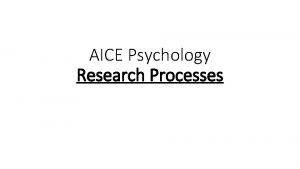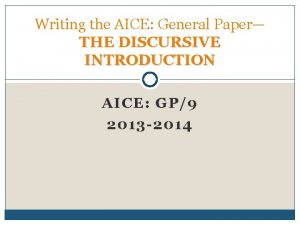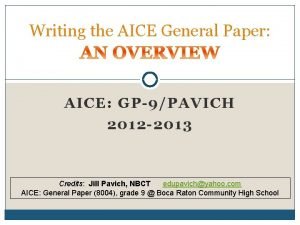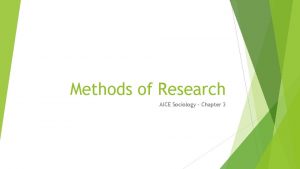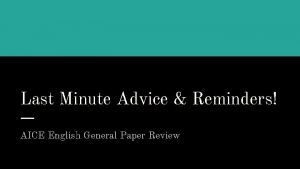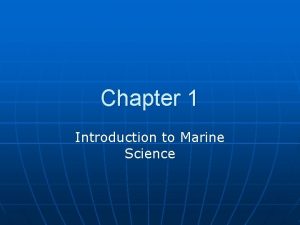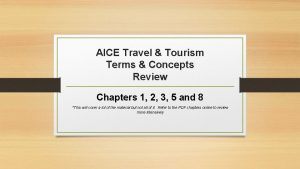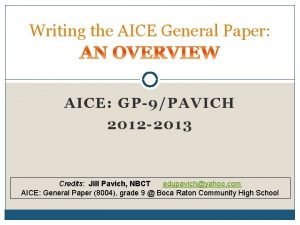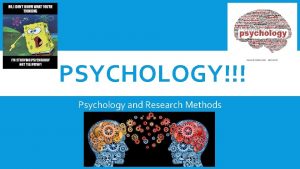AICE Psychology Research Processes Research Processes In this










- Slides: 10

AICE Psychology Research Processes

• Research Processes • In this Power. Point, we will consider: • The different steps a psychologist might take in developing research to investigate a question or problem. • This research process can be thought of as having several steps: • 1. development of an aim and hypothesis (a testable statement predicting a difference between levels of the independent variable{in an experiment} or a relationship between variables {in a correlation}. • 2. selection of a research method and, in an experiment, the experimental design • 3. definition, manipulation, measurement and control of variables • 4. ethical considerations • 5. selection of participants • 6. analysis of data, including the drawing of conclusions • 7. evaluation of research

• Aims and hypotheses • AIMS • The aim tells you the purpose of the investigation. It is often expressed in terms of what the study intends to show. • Example: Consider the idea of different ways to help students to study, perhaps using mind maps, or review apps. • Imagine Dr. Blot, a psychologist asking a few of her psych. students which method they prefer. • She find out that both are quite popular. • Dr. Blot wants to know which is most effective. This is Dr. Blot’s aim – to investigate whether mind maps or review apps are more effective at helping student to learn.

• In a correlation: • The aim is to investigate a link or relationship btwn two measured variables such as between the number of computer games a student plays and their final grade. • HYPOTHESES • To make her research more exact, Dr. Blot needs to present this aim as a hypothesis, that is, as a testable statement. • A hypothesis should provide a little more detail about the variables being investigated than the aim, importantly, a hypothesis should also be falsifiable, that is, it should be possible for it to be shown to be wrong. • The main hypothesis in a study (sometimes called the alternative hypothesis) can be written in several different ways. • These ways differ in terms of the nature of the prediction they make about the results of an investigation.

• Ways to write a hypothesis in psychological research: • Non-directional (two-tailed) hypotheses: • Predicts there will be an effect but not the directions of that effect. • In an experiment, this means that the hypothesis will suggest that the IV will change the DV but not whether the effect will be an increase or a decrease. • This type of hypothesis is chosen if the effect of the variable is being tested for the first time, so there are no previous results to suggest what the results might be. • Example: Dr. Blot’s hypothesis could be: There is a difference between the effectivelness of mind maps and review apps in helping students to learn. • Note that it is predicting a difference, but not which condition will be better at helping with learning. • A non-directional hypothesis in a correlational study predicts that there will be a relationship between the two measured variables. • Example: There will be a correlation between the number of computer games a student plays and their final grade.

• Directional hypotheses • When previous research or other evidence suggests the nature or ’direction’ of an effect, we can use a directional (one tailed) hypothesis. • In an experiment this means saying which condition will be ‘best’ (i. e. produce the ‘highest’ scores) and in a correlational study, whethere will be a positive or negative correlation. • Example: Dr. Blot’s study – there might be evidence that review apps are better than mind maps, perhaps because they are more ‘active’ and being actively engaged helps memory. • This is a directional prediction so the hypothesis might be: Students using review apps will learn better than students using mind maps. • Note that the opposite prediction could also be expresses as a directional hypothesis: Students using mind maps will learn better that students using review apps. • We might make this prediction if we believed that writing a mind map yourself was more effective than just reusing ready-made materials on review apps.

• A directional hypothesis for the correlational study about computer games and grades could say: There will be a negative correlation between the number of computer games a student plays and their final grade. • We might make this prediction if we believed that the time spent playing games might stop students working. • However a different directional hypothesis could be: As the number of computer games a student has increases, their grade increases. • We might make this prediction if we believed that students who engaged more with technology, even through games, were also more likely to benefit from technology-based learning aids. • Remember: Your hypothesis should not say that one factor causes the change in the other.

• Null hypotheses • A null hypothesis is a testable statement saying that any difference or correlation in the results is due to chance, i. e. that no pattern in the results has arisen because of the variables being studied. • In an experiment, the null hypothesis states that any difference in the DV between levels of the IV is so small that it is likely to have arisen by chance. • Example: For Dr. Blot’s study: the null hypothesis could be written either as: There will be no difference between the effectiveness of mind maps and revision apps in helping students to learn. Or Any difference in effectiveness of mind maps and revision apps in helping students to learn is due to chance. • To help you to write null hypotheses for experiments, remember that they should say, “There will be no difference in the DV between condition X and condition Y”, or that “Any difference in the DV between condition X and condition Y is due to chance. ” • Make sure that you always state both of the levels of the IV, and the DV, otherwise your null hypothesis will not make sense. • Example: the null hypothesis: “There is no difference between mind maps and revisions app. ” is meaningless.

• Correlational studies also need a null hypothesis. • These predict either no link or that any relationship could have occurred by chance. • A general null hypothesis for a correlational study reads: There will be no relationship between variable X and variable Y (or Any relationship between variable X and variable Y is due to chance). • Example: There will be no relationship between the number of computer games a student has and their grade (or Any relationship between the number of computer games a student has and their grade is due to chance).

Research Methods in Practice Dr. Blot is thinking about buying new chairs for her classroom. Her aim is to explore whether hard or soft chairs help her students to work better. She wonders whether to predict a nondirectional (two-tailed) hypothesis: There is a difference in work rate of students sitting on comfortable and uncomfortable chairs. Another psychology teacher says that students respond well to other comforts like access to a drinks machine or snack bar, and the soft chairs might make them happier so they work harder. Dr. Blot rewrites her prediction as a directional (onetailed) hypothesis, saying: Students on comfortable chairs will have a higher work rate than ones sitting on uncomfortable chairs. A third teacher is not convinced and suggests that if the students are too comfortable they will become sleepy and lazy, so work less. Thy hypothesis would then be: Students on comfortable chairs will have a lower work rate than ones sitting on uncomfortable chairs. Her null hypothesis would be: Any difference in work rate of students sitting on comfortable and uncomfortable chairs is due to chance. Now imagine a study which aims to look for a link between sleep and emotions. A nondirectional hypothesis might be: There will be a correlation between amount of sleep and emotional reactivity. The possible directional hypothesis could say: There will be a positive correlation between amount of sleep and how emotional someone is. Remember not to say that one factor causes the other to change. The null hypothesis her would be: Any relationship between amount of sleep and emotional reactivity is due to chance.
